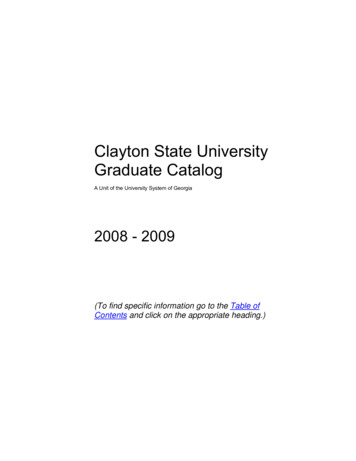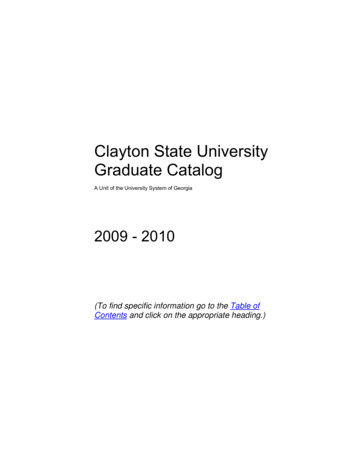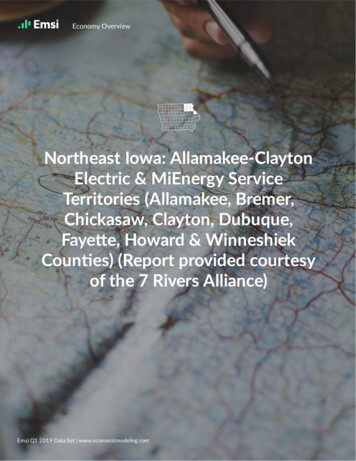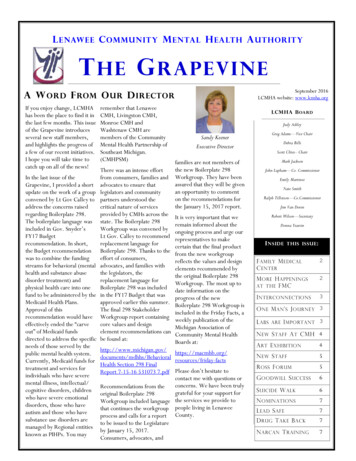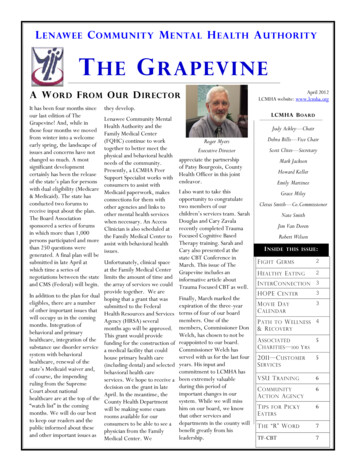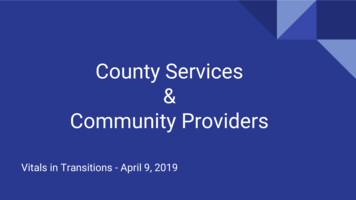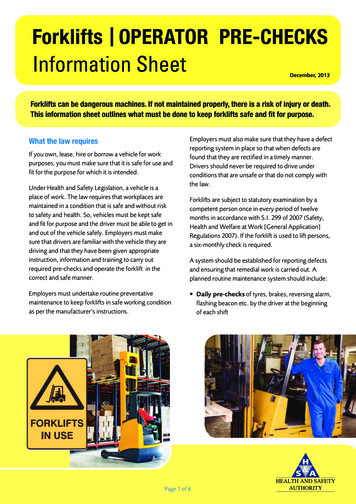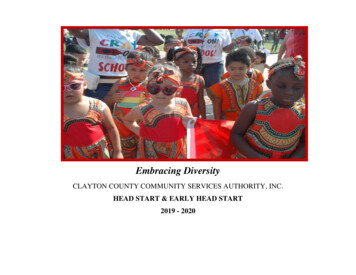
Transcription
Embracing DiversityCLAYTON COUNTY COMMUNITY SERVICES AUTHORITY, INC.HEAD START & EARLY HEAD START2019 - 2020
TABLE OF CONTENTSHISTORY/MISSION STATEMENT3PUBLIC AND PRIVATE FUNDS RECEIVED4BUDGETARY EXPENDITURES4-8PROPOSED BUDGET8ENROLLMENT/ATTENDANCE10 - 11RESULT OF MOST RECENT REVIEWOHS Monitoring10PARENT ENGAGEMENT ACTIVITIES11 - 22CHILD OUTCOMES/TRANSITION TO KINDERGARTEN23- 35COMMUNITY ASSESSMENT UPDATE36 - 61ANNUAL AUDIT REPORT62 - 742
Dear Community Partners,Welcome to our annual report. Improving Head Start for School Readiness Act and the new Head Start Performance Standardsrequire Head Start Programs to annually publish a report to the community they serve.The Clayton County Community Services Authority, Inc. Head Start Program was established in the summer of 1965 as a summerprogram with 60 children and shortly afterwards became a 10-month center-based program. Since the inception the program hasincreased from an enrollment of 60 children to a current enrollment of 352 Head Start, 72 Early Head Start – Child ChildcarePartnership children. We are a center based program with 3 centers - South Avenue has 223 Head Start & 24 Early Head Startchildren, Brookwood center has 129 Head Start children & 16 Early Head Start children, and Bizee Brains Academy which is thepartnership site has 32 Early Head Start – Childcare Expansion (EHS-CCP) children.MISSION STATEMENTThe Clayton County CSA Inc. Head Start / Early Head Start – Child Care Partnership and Pre- K Program provides quality,comprehensive services to low income families with children ages Birth to Five years old, including children with special needs. Weempower families to become self sufficient in order to achieve their life goals; and we promote school readiness, family literacy,social competency, and parental involvement.3
Public and Private Funds Received 2019 -2020FUNDING STREAMSSOURCEFUNDINGHead Start FederalPublic 2,627,701.00Early Head Start –Childcare PartnershipPublic 1,186, 471.00Bright From the Start - StatePublic 830,530.00Bright From the Start – Summer Program - StatePublic 78,000.00USDAPublic 364,514.00In-Kind Contributions –Head StartVolunteers 656,926.00In-Kind Contributions – Early Head Start - Child Care PartnershipsVolunteers 296,617.00Total Funding 6,040,759.00Explanation of the budget expenditures and proposed budget for the fiscal year:Head StartClayton County CSA, Inc. Head Start’s proposed budget dollar amounts above reflect the program funding streams. The actual dollaramounts represent the 12 month budget between 3/1/2019 -2/28/2020 year - 2,627,701. The stated budget for Head Start federalfunds includes an itemized budget for 71 staff salaries,- 1,493,373 fringe benefits - 522,680; totaling - 2,016,053; and 4 nutritionservice staff paid by USDA for a total of 75 Head Start employees; 92,000 - contractual services which includes health, mental4
health & disabilities, dental – N/A; service agreements: computer, fire systems, Xerox copiers, exterminating, safety rugs,communication, drug free workplace, grease removal - 68,722 -other expenses which includes transportation services / vehicleinsurance. general liability insurance for two centers, children insurance, telephone, annual audit fees, utilities, repairs & maintenance,local travel & trainings, parent and male involvement services. 13,000 for out of town travel for meetings, etc Also included in thebudget are supplies: office - janitorial - classroom totaling - 66,000The program strives to increase staff knowledge and professional development through quality trainings; therefore, our staff isprovided with training based on individual needs throughout each fiscal year. The sum of 33,558 is allocated for training & technicalassistance.Indirect cost rates for all federal grants and contracts are periodically reviewed and negotiated with our cognizant federal agency, TheDepartment of Health & Human Services. Approval of the rate is received annually. The program, over the years, has proven to befiscally sound. The sum of 338,368 is allocated for indirect cost to the Grantee - Clayton County Community Service Authority, Inc.Indirect costs are real costs incurred by the agency in support of federal activities which cannot be directly identified with a specificgrant or contract.These costs result from shared services such as administrative personnel, supplies, postage, utilities, rent,advertising, and depreciation for buildings and equipment. These are real costs built into the agency budget. The indirect cost dollarsreceived are not extra dollars but are part of the budget and are fully used to make the system work.In-Kind Services: 696,926The program derives volunteer services from community partners, parents and others individuals throughout the year. These servicesare provided through parent involvement, classroom literacy through the Clayton County Public Libraries, medical services from the5
Clayton County Board of Health & Clayton State University Nurses, dental services from Zoom, Health Advisory Committee,trainings by Peach State Health Plan, Amerigroup, etc.Early Head Start- Child Care Partnership:Clayton County CSA, Inc. Early Head Start – Child Care Partnership proposed budget dollar amounts above reflect the programfunding streams. The actual dollar amounts represent the 12-month budget between 9/1/2019 -8/31/2020 year - 1,186,471.00. Thestated budget for Head Start federal funds includes an itemized budget for 20 staff and 14 support staff salaries - 726,943; fringebenefits - 167,778 totaling - 894,721; and 4 nutrition service staff paid by USDA for a total of 38 Early Head Start employees.Contractual services consist of Child Care partners’ services which cover rental for 4 classrooms and 2 office space rental at BizeeBrains Academy, includes dental, mental health & disabilities & nutrition, totaling 60,048.Other services and expenditures are – Office supplies - 2,114, Janitorial Supplies - 2,500, Classroom supplies and materials 12,366totaling - 16,974Other services and expenditures are – staff travel for home visits 1,000, service agreements- 6,330, space rental at South Avenuecenter for 3 EHS classrooms and 1 staff offices 2,211, utilities 3,500, telephone 1,000, membership dues - 498 Parent services 1,500, liability insurance for 72 children 1,000, Liability Insurance – General, children medical expenses - 1,344, Audit services 2,000 , Repairs and maintenance - 3,067, totaling - 19,9506
The program strives to increase staff knowledge and professional development through quality trainings; therefore our staff isprovided with training based on individual needs throughout each fiscal year. The sum of 27,000.00 is allocated for training &technical assistance.Indirect cost rates for all federal grants and contracts are periodically reviewed and negotiated with our cognizant federal agency, TheDepartment of Health & Human Services. Approval of the rate is received annually. The program, over the years, has proven to befiscally sound. The sum of 167,778.00 is allocated for indirect cost to the Grantee - Clayton County Community Service Authority,Inc. Indirect costs are real costs incurred by the agency in support of federal activities which cannot be directly identified with aspecific grant or contract. These costs result from shared services such as administrative personnel, supplies, postage, utilities, rent,advertising, and depreciation for buildings and equipment. These are real costs built into the agency budget. The indirect cost dollarsreceived are not extra dollars but are part of the budget and are fully used to make the system work.In-Kind Services: - 296,617The program derives volunteer services from community partners, parents and other individuals throughout the year. These servicesare provided through parent involvement, classroom literacy through the Clayton County Public Libraries, medical services from theClayton County Board of Health & Clayton State University Nurses, dental services from Zoom, Health Advisory Committee,trainings by Peach State Health Plan, Amerigroup, etc.Bright From the Start:The sum of 830,530.00 from Bright from the Start was allocated for 90% of 20 Pre-K staff salaries, fringe benefits - 747,477, officesupplies, classroom supplies, repairs and maintenance, employees travel, rent, utilities, telephone, service agreements, andadministrative cost 83,0537
Bright From the Start – Summer ProgramThe sum of 78,000 from Bright from the Start was allocated for 8 Pre-K staff, and 4 part time Transition Coaches salaries and othersupport staff salaries - 52,213.28, fringe benefits - 4,843.48, staff travel – N/A, classroom supplies - 3,000, transportation 4,275.00, transition materials - 3,200, other operating cost - 3,095.98, parent services - 2,692.26, administrative cost - 4,680.00.USDA:Out of 364,514 received from the Department of Agriculture (USDA) and no carryover funds from prior year , 97,800 was allocatedfor 4 nutrition staff salaries, 33,085 for fringe benefits, 23,700 for kitchen, office and program supplies, 5,239 repairs andmaintenance, 1,450 insurance and liability 165,912 for nutritious foods and snacks for the children that we serve, and 36,828 foradministrative cost.The proposed budget for the fiscal year of 2021 - 2022Head Start Continuation 2,773,216.00Early Head Start -CCP 1,244,660.00CARES ACT FUNDING HS 309,340.00CARES ACT FUNDING EHS 63,274.00Bright From the Start for Pre-K 817,368.90Bright From the Start –Summer Program 0.00USDA 364,514.008
In-Kind Contributions -HS 693,304.00In-Kind Contributions –EHS 311,165.00Total Funding 6,576,843.90Data below is a summation from program childplus monitoring tool. Office of Head Startgranted a waiver for 2019 - 2020 Program Information Report (PIR) due to COVID -19pandemic that halted in –person program services.Enrollment information for Head Start 2019- 2020 school yearTotal number of families served – 405This number includes Head Start Pre-K blended services and those that were enrolled and left the program before the school year end.Average monthly enrollment – 89.53%This is the average monthly enrollment when school was in operation from August 2019- May 2020.Percentage of eligible children served – 97.2%Percentage of enrolled children that received medical and dental exams:Medical90%Dental84%9
Enrollment information for Early Head Start –CCP 2019- 2020 school yearTotal number of families served – 82This number includes 40 Expansion children serve at South Avenue & Brookwood centers, 32 serve at Bizee Brains Academy centers,and also those that were enrolled but left the program before the school year end.Average monthly enrollment – 90.41%This is the average monthly enrollment when school was in operation from August 2019 - June 2020.Percentage of eligible children served – 99%Percentage of enrolled children that received medical exams and dental homes:MedicalDental86%86%Most Recent reviews / Audit reports:Our Head Start program and Early Head Start –Child Care Partnership (EHS –CCP) received notice for upcoming review for the 2021fiscal year.Our audit annual report of July 2019 was in compliance with only technical assistance information from the auditors. (See documentattached10
Parent Engagement and Activities:Every center in our program has parent committees and all parents whose children are enrolled in Head Start are members. Meetingsare held on a monthly basis. Annually, Head Start parents conduct elections at each center and select parents based on the formula ofevery 40 children to one parent, and Early Head Start formula is 20 children to one parent as Policy Council members. Alternates arealso elected from every center should a member be absent from the Policy Council meeting.Parents are involved in all facets of the program’s activities – from curriculum planning to making decisions on how to use parentactivity funds, planning events, monthly meetings, and providing in-put on staff selection/hiring.In addition to the above named activities the program recognizes fatherhood and male involvement as a vital part of their child’sgrowth and development; hence, we have monthly meetings for our fathers/male participation. These meetings are always planned bythem with speakers based on approved topics. The program has planned monthly sports activities geared towards our male family’sinterests. Some of the activities previously planned were T-Ball Day, Kite Day, Soccer Day and Basketball Shoot out.Our program is highly diverse and annually we celebrate our diversity. Our parents and the community play an important role ininitiating our Diversity Day Celebration. During the weeks leading up to the event, parents are excitedly assisting with decorating theclassrooms to reflect the country that was chosen by their child’s teacher. Parents learn along with their child about the culture of thedifferent countries selected. This school year Annual Diversity Day did not hold due to COVID -19 pandemic.11
Male Engagement12
Father –Daughter night at one of the centers February 2020Parents are encouraged to volunteer in the classroom on a daily basis. A large emphasis is placed on them reading to their children tostrengthen and build language and literacy skills for the child as well as themselves. Parents are asked to chaperone on field trips toprovide extra safety precautions. Annually, our parents complete a Parent Questionnaire which assists us in evaluating our program.Parents are made aware that they may volunteer in any capacity of the program within the guidelines of the Center’s Policies &Procedures, State Childcare Regulatory laws and Head Start Program Performance Standards.13
Parent Engagement Survey Graph 2019-2020The Clayton County Community Services Authority Inc., Head Start / Pre-K Program, conducted its Family Outcomes Analysis forthe 2019 -2020 school year using the Child Plus Monitoring System data. The outcome data based on each categories was counted,tabulated, divided per number of activities to get the actual average number of families, then graphed to show families progress suchas – Strength (3 scores being highest) Making progress ( 2 scores being the mid scores) and Need Assistance (1 score being the lowestscores). The outcome assessment was conducted 2 times this school year due to Covid-19 pandemic.2019-2020 FALL AND WINTER SCHOOL YEAR FAMILY OUTCOMES CHECKPOINT14
FALLFamily Wellbeing: -Based on the above data of accumulative average of families’ participation, the 1st. Checkpoint of FamilyOutcome report shows that 254 families participated in the assessment. 57% families obtained the highest score of 3 - strength, 38%families obtained 2 –making progress, and 5% families obtained 1 - need assistance.WINTERFamily Wellbeing- Based on the above data of accumulative average of families’ participation, the 2nd Checkpoint ofFamily Outcome report shows that 327 families participated in the assessment. 69.5% families obtained the highest score of 3 strength, 29% families obtained 2 –making progress, and 1.4% families obtained 1 - need assistance. The program will ensure thatparents are given the support in the areas that are showing progress and the areas where assistance is needed.15
FALLPositive Parent Child Behavior: - Based on the above data of accumulative average of families’ participation, the 1st. Checkpoint ofFamily Outcome report shows that 254 families participated in the assessment. 58% families obtained the highest score of 3 strength, 40% families obtained 2 –making progress, and 2% families obtained 1 - need assistance.WINTERPositive Parent Child Behavior: -Based on the above data of accumulative average of families’ participation, the 2nd Checkpoint ofFamily Outcome report shows that 327 families participated in the assessment. 66.4% families obtained the highest score of 3 strength, 32.6% families obtained 2 –making progress, and 1% families obtained 1 - need assistance. The program will ensurethat parents are given the support in the areas that are making progress and the areas where assistance is needed.16
FALLFamilies as Lifelong Educators: -Based on the above data of accumulative average of families’ participation, the 1st. Checkpoint ofFamily Outcome report shows that 254 families participated in the assessment. 49% families obtained the highest score of 3 strength, 47% families obtained 2 –making progress, and 4% families obtained 1 - need assistance.17
WINTERFamilies as Lifelong Educators: -Based on the above data of accumulative average of families’ participation, the 2nd Checkpoint ofFamily Outcome report shows that 327 families participated in the assessment. 56.01% families obtained the highest score of 3 strength, 42.6% families obtained 2 –making progress, and 1.3% families obtained 1 - need assistance. The program will ensurethat parents are given the support in the areas that are making progress and the areas where assistance is needed.18
FALLFamily as Learners: - Based on the above data of accumulative average of families’ participation, the 1st. Checkpoint of FamilyOutcome report shows that 254 families participated in the assessment. 46% families obtained the highest score of 3 - strength, 50%families obtained 2 –making progress, and 4% families obtained 1 - need assistance.WINTERFamily as Learners: Based on the above data of accumulative average of families’ participation, the 2nd Checkpoint of FamilyOutcome report shows that 327 families participated in the assessment. 54.96% families obtained the highest score of 3 - strength,43.1% families obtained 2 –making progress, and 1.9% families obtained 1 - need assistance. The program will ensure that parentsare given the support in the areas that are making progress and the areas where assistance is needed.19
FALLFamily Engagement in Transitions:- Based on the above data of accumulative average of families’ participation, the 1st. Checkpointof Family Outcome report shows that 254 families participated in the assessment. 37% families obtained the highest score of 3 strength, 50% families obtained 2 –making progress, and 13% families obtained 1 - need assistance.WINTERFamily Engagement in Transitions:- Based on the above data of accumulative average of families’ participation, the 2nd Checkpointof Family Outcome report shows that 327 families participated in the assessment. 52.7% families obtained the highest score of 3 strength, 45.4% families obtained 2 –making progress, and 1.8% families obtained 1 - need assistance. The program will ensurethat parents are given the support in the areas that are making progress and the areas where assistance is needed.20
FALLFamily Connections to Peers and Community:- Based on the above data of accumulative average of families’ participation, the 1st.Checkpoint of Family Outcome report shows that 254 families participated in the assessment. 35% families obtained the highest scoreof 3 - strength, 53% families obtained 2 –making progress, and 12% families obtained 1 - need assistance.WINTERFamily Connections to Peers and Community:- Based on the above data of accumulative average of families’ participation, the 2ndCheckpoint of Family Outcome report shows that 327 families participated in the assessment. 37.3% families obtained the highestscore of 3 - strength, 55.1% families obtained 2 –making progress, and 7.5% families obtained 1 - need assistance. The programwill ensure that parents are given the support in the areas that are making progress and the areas where assistance is needed.Families Advocates and LeadersFallWinterStrength115150Making Progress105124Need Assistance344321
FALLFamilies as Advocates and Leaders:- Based on the above data of accumulative average of families’ participation, the 1st.Checkpoint of Family Outcome report shows that 254 families participated in the assessment. 45% families obtained the highest scoreof 3 - strength, 41% families obtained 2 –making progress, and 14% families obtained 1 - need assistance.WINTERFamilies as Advocates and Leaders:- Based on the above data of accumulative average of families’ participation, the 2ndCheckpoint of Family Outcome report shows that 327 families participated in the assessment. 49% families obtained the highest scoreof 3 - strength, 37.8% families obtained 2 –making progress, and 13.2% families obtained 1 - need assistance. The program willensure that parents are given the support in the areas that are making progress and the areas where assistance is needed.Improvement PlanThe Family Service Workers will continue to communicate and engage with the parents on a regular basis as it pertains to their familygoals, and meeting those goals before the families transition to public school or private institutions of learning the next school year.22
Child Outcome/Transition to Kindergarten:The Clayton County Community Services Authority, Inc. Head Start Program school readiness goal is to ensure that all childrenenrolled in our program receives quality education skills that will ensure their readiness to enter Kindergarten.Our program curriculum is Creative Curriculum and our assessment tool is Teaching Strategies Goal. We assess children birth to five,3 times a year (Fall - August through November, Winter - November through February, and Spring - February through May); Hencechildren are assessed every 60 days of 180 days of Head Start (1170 hours) and 67 days of 203 days of Early Head Start – Child CarePartnership (1384 hours) programs operations.At every assessment checkpoint data is collected, aggregated and graphed for results and outcomes. Based on the outcomes, programplans and goals will change to meet the academic expectations of the children.The program’s school readiness classroom goals for the year has been established and are designed to ensure continued academiclearning and viable social skills, which are necessary for a smooth transition into Kindergarten. These goals may change according tothe results yielded during checkpoints to meet the academic expectations of the children.23
Teaching Strategies GOLD Assessment CheckpointClayton County Community Services Authority Inc., Head Start program conducted assessment checkpoint for the 2019 – 2020school year using the Teaching Strategies GOLD Assessment Tool for Head Start. The TSG Assessment is conducted 3 times duringthe school year (Fall, Winter and Spring) and the assessed data is aggregated and charted to track child outcomes results. This datawhich is aligned to the GELDS and HSELOF is used to produce the program’s School Readiness classroom goals. The goals arebeneficial as it assist the children to meet the objectives in the TSG Assessment and ensure continued academic learning and viablesocial skills, which are necessary for a smooth and successful transition into Kindergarten.The graphs below show the progress of 206 children Head Start Transition, out of 210 for the winter checkpoint, as well as thefall checkpoint (209 out of 212), for comparison.24
Social Emotional Development25
Physical Health and Development26
Language & Literacy Development27
COGNITION & GENERAL KNOWLEDGE (including Mathematics)Approaches to Learning28
English Language Acquisition (72) (69)SUMMARYWinter and Fall Comparison (Head Start/Pre-K)The Clayton County CSA Inc., Winter Assessment checkpoint ended February 14, 2020 at which time there were a total of 206children with enough recorded TSG assessment data. These results reflect children that are transitioning or beginning public school forthe first time. Teachers plan strategies for improvement for each child based on their assessment with input from parentsThe graphs above show the progress of the transitioning children in each of the 5 domains (Social Emotional Development, Physical(Fine & Gross Motor) Development, Language & Literacy, Cognition and Approaches to Learning). It also shows the progress of theDual Language Learners as they learn to understand and speak the English Language. These domains serve as a means to guidechildren towards school readiness and age appropriate development.29
Based on the above graphed data for the winter checkpoint the children’s greatest areas of strength are Approaches to Learningwith (74%)of the children Exceeding Program Expectations and Social Emotional Development with (53%)of the children alsoExceeding Program Expectations. Although there is a drastic decrease from the fall in the area Cognition, it remains the area ofweakness in comparison to the other domains with (7%) in the Not yet/below category.In all domains combined, only (4%) of the children overall, are in the Below/Not yet category, while (53%)are in theemerging/meeting program expectations category and(43%)are exceeding program expectations.COMPARISONThere were 206 out of 210 children for the winter checkpoint in comparison to 212 out of 209 for the fall checkpoint. Incomparison with the Fall Assessment, the progress of the children has increased by (19%) in emerging/meeting programexpectations and by (30%) in the exceeding program expectations. There is a decrease of (9%) in the Not yet/below categorywhich lends to strengths in other areas.At the winter checkpoint, (86%) of the Dual Language Learners are at Level 5 or higher, which is a (31%) increase from the fallcheckpoint assessment.30
Program Improvement Plans for the 2020 - 2021 school year is as follows:(Due to COVID-19, currently all training will be conducted on a Virtual Platform)1. Currently the Clayton County CSA, Inc. Head Start program began the year in a Distance Learning/Virtual Modelstatus due to COVID-19. The program has and is currently utilizing the Zoom and Google meet platforms for virtuallearning. As of October 26, 2020, the program added the Hybrid Model for parent that have expressed a desire to havetheir children return to the classroom. However, some parents have expressed the desire to remain with the DistanceLearning Model. Parents are provided with educational materials at home to assist their children with on-screen,individualized, and independent learning activities planned by the teachers. Lesson plans are posted one week inadvance, in the virtual Google classroom for the benefit of the parents to help them prepare more efficiently for thelessons and activities.2. The Program will continue to provide the Head Start Teaching Staff with more T & TA assistance through the efficiency andexpertise of our Mentor Coaches and Education Specialist as well as outside trainers as needed. The Mentor Coaches willprovide ongoing teacher classroom observations and modeling, for a better understanding of the Curriculum, CLASS scores,and TSG assessments. Although CLASS observations are not currently conducted, the Education Specialist do observedvirtually, viewing and listening for areas that reflect the usage of the dimensions and indicators of the domains ofEmotional Support, Classroom Organization and Instructional Support. The Education Specialist and other Reliable31
observers share information to make comparisons with TSG outcomes, and to use for Training purposes to strengthenteaching staff in the CLASS domains. The Education Specialist will also continue to bring in outside professionaltrainers to provide training in areas of need.3. Curriculum/Assessment - The program plan to purchase the TS Creative Curriculum Expansion Kits for all HeadStart Classrooms. Teachers will also be encouraged to make suggestions of other needs that they may have. The EducationSpecialist will share TSG assessment outcomes with the Mentor Coaches to assist teaching staff in developing more effectiveways to support learning, child development and growth in the classroom. The Program will continue to provideclassrooms with more age appropriate materials to execute activities on weekly Lesson Plans and the monthly HomeCenter Activities worksheet to strengthen the child’s abilities to master the skills necessary to progress in this domain.The Parent Individualized Home Center Activity form has been revised to encourage more parent engagement and will be acontinual tool to provide a means for parents to be engaged in their child’s Head Start Learning experiences.4. School Readiness Goals for the 2020 -2021 school year will continue to reflect areas of development in each of the fivedomains (Social Emotional, Physical Health & Development, Language & Literacy, Cognition and Approaches to Learning.The classroom teaching staff will also receive a School readiness Chart that has been aligned with the GELDS and TSG goalsand objectives to further assist meeting the child’s educational learning needs. The program will continue to use the Birth toFive Head Start Early Learning Outcomes Framework, to meet the needs of the 3-year olds that will be transitioning to the PreK classrooms as well as the 4-year olds that will be transitioning to Kindergarten. All classrooms were given a copy of the32
HSELOF, for more support in providing age appropriate activities. The program revised the Head Start Lesson Plan usingthe BFTS Template for Virtual classroom planning and organization which reflects the Creative Curriculum, TSGassessment and GELDS (which are all aligned with HSELOF). All teaching staff received training on how to executethe new lesson plan as well as a sample copy as a guide in order to provide meaningful learning activities to ensure that atleast 80% or more of the children will be able to master their school readiness goals.Transition to Kindergarten –Due to COVID -19 pandemic, the transition exercise activities to scheduled at different Elementary Schools in Clayton County werecanceled, but that did not stopped the program to provide transition to Kindergarten resources to our children and families, to helptheir children ready for Kinder
Clayton County Board of Health & Clayton State University Nurses, dental services from Zoom, Health Advisory Committee, trainings by Peach State Health Plan, Amerigroup, etc. Bright From the Start: The sum of 830,530.00 from Bright from the Start was allocated for 90% of 20


